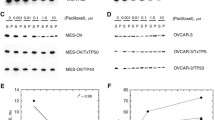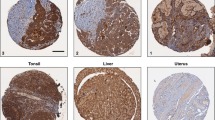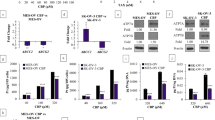ABSTRACT
Purpose
Acquired β-tubulin alterations in human ovarian carcinoma 1A9 cells were previously shown to confer resistance to the microtubule stabilizing agents peloruside A (PLA) and laulimalide (LAU). We examined the proteome of resistant cells to see what other protein changes occurred as a result of the acquired drug resistance.
Methods
Two-dimensional differential in-gel electrophoresis was performed to explore differentially expressed proteins in the resistant 1A9-R1 (R1) and 1A9-L4 (L4) cells. The proteins on the gels were identified by MALDI-TOF MS, and altered protein abundance was confirmed by Western blotting and immunocytochemistry. Vimentin expression was restored in vimentin-deficient L4 cells by transfecting a full-length human vimentin cDNA, and sensitivity to PLA and LAU were tested using an MTT cell proliferation assay.
Results
Proteomic analysis identified several proteins that were significantly altered in the resistant cells relative to the parental 1A9 cells. Using Western blotting and immunocytochemistry, a decreased vimentin abundance in the L4 cells was validated. Vimentin levels were unchanged in PLA-resistant R1 cells and paclitaxel/epothilone-resistant derivatives of 1A9 cells. Vimentin cDNA transfection into L4 cells partially restored PLA and LAU sensitivity.
Conclusions
Downregulation of vimentin contributes to the resistance of 1A9 cells to the microtubule stabilizing agents, PLA and LAU.




Similar content being viewed by others
Abbreviations
- 2D-DIGE:
-
two-dimensional differential in-gel electrophoresis
- BVA:
-
biological variation analysis
- DAPI:
-
4′,6-diamidino-2-phenylindole
- DOX:
-
doxorubicin
- IXA:
-
ixabepilone
- LAU:
-
laulimalide
- MALDI-TOF:
-
matrix assisted laser desorption/ionization time of flight
- P-gp:
-
P-glycoprotein
- PLA:
-
peloruside A
- PTX:
-
paclitaxel
- VDP:
-
vimentin degradation products
REFERENCES
Steinert PM, Roop DR. Molecular and cellular biology of intermediate filaments. Annu Rev Biochem. 1988;57:593–625.
Franke WW, Schmid E, Winter S, Osborn M, Weber K. Widespread occurrence of intermediate-sized filaments of the vimentin-type in cultured cells from diverse vertebrates. Exp Cell Res. 1979;123(1):25–46.
Dráberová E, Dráber P. A microtubule-interacting protein involved in coalignment of vimentin intermediate filaments with microtubules. J Cell Sci. 1993;106(4):1263–73.
Esue O, Carson AA, Tseng Y, Wirtz D. A direct interaction between actin and vimentin filaments mediated by the tail domain of vimentin. J Biol Chem. 2006;281(41):30393–9.
Satelli A, Li S. Vimentin in cancer and its potential as a molecular target for cancer therapy. Cell Mol Life Sci. 2011;68(18):3033–46.
Zhu QS, Rosenblatt K, Huang KL, Lahat G, Brobey R, Bolshakov S, et al. Vimentin is a novel AKT1 target mediating motility and invasion. Oncogene. 2011;30(4):457–70.
Nijkamp MM, Span PN, Hoogsteen IJ, van der Kogel AJ, Kaanders JH, Bussink J. Expression of E-cadherin and vimentin correlates with metastasis formation in head and neck squamous cell carcinoma patients. Radiother Oncol. 2011;99(3):344–8.
Liang Y, McDonnell S, Clynes M. Examining the relationship between cancer invasion/metastasis and drug resistance. Curr Cancer Drug Targets. 2002;2(3):257–77.
Dumontet C, Jordan MA. Microtubule-binding agents: a dynamic field of cancer therapeutics. Nat Rev Drug Discov. 2010;9(10):790–803.
Gottesman MM, Fojo T, Bates SE. Multidrug resistance in cancer: role of ATP -dependent transporters. Nat Rev Cancer. 2002;2(1):48–58.
Kavallaris M. Microtubules and resistance to tubulin-binding agents. Nat Rev Cancer. 2010;10(3):194–204.
Verrills NM, Po’uha ST, Liu ML, Liaw TY, Larsen MR, Ivery MT, et al. Alterations in gamma-actin and tubulin-targeted drug resistance in childhood leukemia. J Natl Cancer Inst. 2006;98(19):1363–74.
Zhou M, Liu Z, Zhao Y, Ding Y, Liu H, Xi Y, et al. MicroRNA-125b confers the resistance of breast cancer cells to paclitaxel through suppression of pro-apoptotic Bcl-2 antagonist killer 1 (Bak1) expression. J Biol Chem. 2010;285(28):21496–507.
Grzanka A, Grzanka D, Orlikowska M. Cytoskeletal reorganization during process of apoptosis induced by cytostatic drugs in K-562 and HL-60 leukemia cell lines. Biochem Pharmacol. 2003;66(8):1611–7.
Grzanka A, Grzanka D, Orlikowska M, Zuryn A, Grzanka A. Estimation of taxol influence on changes in tubulin and vimentin systems in K-562 and HL-60 cell lines by immunofluorescence microscopy. Neoplasma. 2005;52(3):193–8.
Sun QL, Sha HF, Yang XH, Bao GL, Lu J, Xie YY. Comparative proteomic analysis of paclitaxel sensitive A549 lung adenocarcinoma cell line and its resistant counterpart A549-Taxol. J Cancer Res Clin Oncol. 2011;137(3):521–32.
Kabos P, Haughian JM, Wang X, Dye WW, Finlayson C, Elias A, et al. Cytokeratin 5 positive cells represent a steroid receptor negative and therapy resistant subpopulation in luminal breast cancers. Breast Cancer Res Treat. 2011;128(1):45–55.
Bauman PA, Dalton WS, Anderson JM, Cress AE. Expression of cytokeratin confers multiple drug resistance. Proc Natl Acad Sci U S A. 1994;91(12):5311–4.
Mooberry SL, Tien G, Hernandez AH, Plubrukarn A, Davidson BS. Laulimalide and isolaulimalide, new paclitaxel-like microtubule stabilizing agents. Cancer Res. 1999;59(3):653–60.
Hood KA, West LM, Rouwé B, Northcote PT, Berridge MV, Wakefield SJ, et al. Peloruside A, a novel antimitotic agent with paclitaxel-like microtubule stabilizing activity. Cancer Res. 2002;62(12):3356–60.
Kanakkanthara A, Wilmes A, O’Brate A, Escuin D, Chan A, Gjyrezi A, et al. Peloruside- and laulimalide-resistant human ovarian carcinoma cells have βI-tubulin mutations and altered expression of βII- and βIII-tubulin isotypes. Mol Cancer Ther. 2011;10(8):1419–29.
Gaitanos TN, Buey RM, Díaz F, Northcote PT, Spittle PT, Andreu JM, et al. Peloruside A does not bind to the taxoid site on β-tubulin and retains its activity in multidrug-resistant cell lines. Cancer Res. 2004;64(15):5063–7.
Pryor DE, O’Brate A, Bilcer G, Díaz JF, Wang Y, Wang Y, et al. The microtubule stabilizing agent laulimalide does not bind in the taxoid site, kills cells resistant to paclitaxel and epothilones, and may not require its epoxide moiety for activity. Biochemistry. 2002;41(29):9109–15.
Kanakkanthara A, Northcote PT, Miller JH. βII-Tubulin and βIII-tubulin mediate sensitivity to peloruside A and laulimalide, but not paclitaxel or vinblastine, in human ovarian carcinoma cells. Mol Cancer Ther. 2012;11(2):393–404.
Giannakakou P, Sackett DL, Kang YK, Zhan Z, Buters JTM, Fojo T, et al. Paclitaxel-resistant human ovarian cancer cells have mutant β-tubulins that exhibit impaired paclitaxel-driven polymerization. J Biol Chem. 1997;272(27):17118–25.
Giannakakou P, Gussio R, Nogales E, Downing KH, Zaharevitz D, Bollbuck B, et al. A common pharmacophore for epothilone and taxanes: molecular basis for drug resistance conferred by tubulin mutations in human cancer cells. Proc Natl Acad Sci U S A. 2000;97(6):2904–9.
Kajiyama H, Shibata K, Terauchi M, Yamashita M, Ino K, Nawa A, et al. Chemoresistance to paclitaxel induces epithelial-mesenchymal transition and enhances metastatic potential for epithelial ovarian carcinoma cells. Int J Oncol. 2007;31(2):277–83.
Işeri OD, Kars MD, Arpaci F, Atalay C, Pak I, Gündüz U. Drug resistant MCF-7 cells exhibit epithelial-mesenchymal transition gene expression pattern. Biomed Pharmacother. 2011;65(1):40–5.
Goldman RD, Khuon S, Chou YH, Opal P, Steinert PM. The function of intermediate filaments in cell shape and cytoskeletal integrity. J Cell Biol. 1996;134(4):971–83.
Vilalta PM, Zhang L, Hamm-Alvarez SF. A novel taxol-induced vimentin phosphorylation and stabilization revealed by studies on stable microtubules and vimentin intermediate filaments. J Cell Sci. 1998;111(13):1841–52.
Janosch P, Kieser A, Eulitz M, Lovric J, Sauer G, Reichert M, et al. The Raf-1 kinase associates with vimentin kinases and regulates the structure of vimentin filaments. FASEB J. 2000;14(13):2008–21.
Goto H, Tanabe K, Manser E, Lim L, Yasui Y, Inagaki M. Phosphorylation and reorganization of vimentin by p21-activated kinase (PAK). Genes Cells. 2002;7(2):91–7.
Goto H, Yasui Y, Kawajiri A, Nigg EA, Terada Y, Tatsuka M, et al. Aurora-B regulates the cleavage furrow-specific vimentin phosphorylation in the cytokinetic process. J Biol Chem. 2003;278(10):8526–30.
Nitta T, Kim JS, Mohuczy D, Behrns KE. Murine cirrhosis induces hepatocyte epithelial-mesenchymal transition and alterations in survival signaling pathways. Hepatology. 2008;48(3):909–19.
Tzivion G, Luo ZJ, Avruch J. Calyculin A-induced vimentin phosphorylation sequesters 14-3-3 and displaces other 14-3-3 partners in vivo. J Biol Chem. 2000;275(38):29772–8.
Peñuelas S, Noé V, Ciudad CJ. Modulation of IMPDH2, survivin, topoisomerase I and vimentin increases sensitivity to methotrexate in HT29 human colon cancer cells. FEBS J. 2005;272(3):696–710.
Lopes EC, García MG, Vellón L, Alvarez E, Hajos SE. Correlation between decreased apoptosis and multidrug resistance (MDR) in murine leukemic T cell lines. Leuk Lymphoma. 2001;42(4):775–87.
Wilson KS, Roberts H, Leek R, Harris AL, Geradts J. Differential gene expression patterns in HER2/neu-positive and -negative breast cancer cell lines and tissues. Am J Pathol. 2002;161(4):1171–85.
Miller JH, Rouwé B, Gaitanos TN, Hood KA, Crume KP, Bäckström BT, et al. Peloruside A enhances apoptosis in H-ras-transformed cells and is cytotoxic to proliferating T cells. Apoptosis. 2004;9(6):785–96.
Prasad SC, Thraves PJ, Kuettel MR, Srinivasarao GY, Dritschilo A, Soldatenkov VA. Apoptosis-associated proteolysis of vimentin in human prostate epithelial tumor cells. Biochem Biophys Res Commun. 1998;249(2):332–8.
Morishima N. Changes in nuclear morphology during apoptosis correlate with vimentin cleavage by different caspases located either upstream or downstream of Bcl-2 action. Genes Cells. 1999;4(7):401–14.
Byun Y, Chen F, Chang R, Trivedi M, Green KJ, Cryns VL. Caspase cleavage of vimentin disrupts intermediate filaments and promotes apoptosis. Cell Death Differ. 2001;8(5):443–50.
Lahat G, Zhu QS, Huang KL, Wang S, Bolshakov S, Liu J, et al. Vimentin is a novel anti-cancer therapeutic target; insights from in vitro and in vivo mice xenograft studies. PLoS One. 2010;5(4):e10105.
Wilmes A, Chan A, Rawson P, William Jordan T, Miller JH. Paclitaxel effects on the proteome of HL-60 promyelocytic leukemic cells: comparison to peloruside A. Invest New Drugs. 2012;30(1):121–9.
ACKNOWLEDGMENTS AND DISCLOSURES
The authors thank Dr. Paraskevi Giannakakou for kindly providing the 1A9 and the resistant L4, PTX-10, and A8 cell lines. This research was supported by grants to J.H.M from the Cancer Society of New Zealand, the Wellington Medical Research Foundation, and Victoria University of Wellington.
Author information
Authors and Affiliations
Corresponding author
Rights and permissions
About this article
Cite this article
Kanakkanthara, A., Rawson, P., Northcote, P.T. et al. Acquired Resistance to Peloruside A and Laulimalide is Associated with Downregulation of Vimentin in Human Ovarian Carcinoma Cells. Pharm Res 29, 3022–3032 (2012). https://doi.org/10.1007/s11095-012-0773-x
Received:
Accepted:
Published:
Issue Date:
DOI: https://doi.org/10.1007/s11095-012-0773-x




